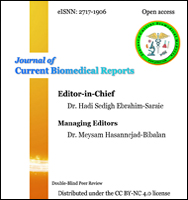Evaluation the intestinal level of LCN2/NGAL in patients with Clostridium difficile infection in the south of Iran
Abstract
Clostridium difficile is a Gram-positive obligate anaerobic bacterium that recognized an important pathogen of humans. The present study aimed to evaluate the intestinal level of neutrophil gelatinase-associated lipocalin (NGAL) in patients with C. difficile infection (CDI) as a disease activity marker in the south of Iran. This cross-sectional study conducted from October 2017 to June 2018 on patients referred to Nemazee and Amir Hospital in Shiraz, South of Iran. Patients less than two years old were excluded from the study. The study population was consist of 46 cases (Symptomatic patients that confirmed as a CDI), and 21 control individuals (Asymptomatic patients colonized by C. difficile). C. difficile isolates were identified by conventional microbiological producers and amplification of housekeeping gene by PCR method. The level of NGAL was determined by enzyme-linked immunosorbent assay (ELISA) according to the instructions of the kit manufacturer. The results showed that the level of NGAL in symptomatic patients' (case group) was higher than asymptomatic carriers (control group), 5.9 ng/mL vs. 4.1 ng/mL; however the observed difference was not statistically significant. Also, in both groups, the mean level of NGAL was significantly higher in patients with gastrointestinal diseases than others. In summary, despite all the limitations, the results of the present study indicate that the intestinal level of NGAL is a biological indicator of intestinal inflammation, regardless of CDI. However, further study needs to elucidate the role of NGAL in inflammation caused by bacterial infections.
Keywords
References
Edwards AN, Suárez JM, McBride SM. Culturing and maintaining Clostridium difficile in an anaerobic environment. J Vis Exp. 2013; (79):e50787.
Curry S. Clostridium difficile. Clin Lab Med. 2010; 30(1):329-42.
Karaaslan A, Soysal A, Yakut N, Akkoç G, Demir SO, Atıcı S, et al. Hospital acquired Clostridium difficile infection in pediatric wards: a retrospective case-control study. Springerplus. 2016; 5(1):1329.
Lawson PA, Citron DM, Tyrrell KL, Finegold SM. Reclassification of Clostridium difficile as Clostridioides difficile (Hall and O'Toole 1935) Prévot 1938. Anaerobe. 2016; 40:95-9.
Kjeldsen L, Cowland JB, Borregaard N. Human neutrophil gelatinase-associated lipocalin and homologous proteins in rat and mouse. Biochim Biophys Acta Protein Struct Molec Enzym. 2000; 1482(1):272-83.
Chakraborty S, Kaur S, Guha S, Batra SK. The multifaceted roles of neutrophil gelatinase associated lipocalin (NGAL) in inflammation and cancer. Biochim Biophys Acta. 2012; 1826(1):129-69.
Chassaing B, Srinivasan G, Delgado MA, Young AN, Gewirtz AT, Vijay-Kumar M. Fecal lipocalin 2, a sensitive and broadly dynamic non-invasive biomarker for intestinal inflammation. PLoS One. 2012; 7(9):e44328.
Bolignano D, Donato V, Coppolino G, Campo S, Buemi A, Lacquaniti A, et al. Neutrophil gelatinase-associated lipocalin (NGAL) as a marker of kidney damage. Am J Kidney Dis. 2008; 52(3):595-605.
Deis JA, Guo H, Wu Y, Liu C, Bernlohr DA, Chen X. Adipose Lipocalin 2 overexpression protects against age-related decline in thermogenic function of adipose tissue and metabolic deterioration. Mol Metab. 2019; 24:18-29.
Lemee L, Dhalluin A, Testelin S, Mattrat MA, Maillard K, Lemeland JF, et al. Multiplex PCR targeting tpi (triose phosphate isomerase), tcdA (Toxin A), and tcdB (Toxin B) genes for toxigenic culture of Clostridium difficile. J Clin Microbiol. 2004; 42(12):5710-4.
Sedigh Ebrahim-Saraie H, Heidari H, Amanati A, Bazargani A, Alireza Taghavi S, Nikokar I, et al. A multicenter-based study on epidemiology, antibiotic susceptibility and risk factors of toxigenic Clostridium difficile in hospitalized patients in southwestern Iran. Infez Med. 2018; 26(4):308-15.
Depestel DD, Aronoff DM. Epidemiology of Clostridium difficile infection. J Pharm Pract. 2013; 26(5):464-75.
Furuya-Kanamori L, Marquess J, Yakob L, Riley TV, Paterson DL, Foster NF, et al. Asymptomatic Clostridium difficile colonization: epidemiology and clinical implications. BMC Infect Dis. 2015; 15:516.
Guo BX, Wang QQ, Li JH, Gan ZS, Zhang XF, Wang YZ, et al. Lipocalin 2 regulates intestine bacterial survival by interplaying with siderophore in a weaned piglet model of Escherichia coli infection. Oncotarget. 2017; 8(39):65386-96.
Singh V, Yeoh BS, Chassaing B, Zhang B, Saha P, Xiao X, et al. Microbiota-inducible Innate Immune, Siderophore Binding Protein Lipocalin 2 is Critical for Intestinal Homeostasis. Cell Mol Gastroenterol Hepatol. 2016; 2(4):482-98.e6.
DOI: https://doi.org/10.52547/jcbior.1.1.27
Refbacks
- There are currently no refbacks.
Copyright (c) 2020 © The Author(s)

This work is licensed under a Creative Commons Attribution-NonCommercial 4.0 International License.













